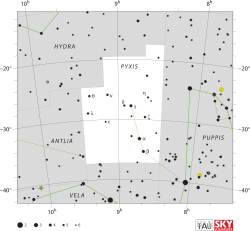| Observation data Epoch J2000 Equinox J2000 | |
|---|---|
| Constellation | Pyxis |
| Right ascension | 08h 40m 06.14363s[1] |
| Declination | –35° 18′ 30.0″[1] |
| Apparent magnitude (V) | 3.954[2] |
| Characteristics | |
| Spectral type | G7II/III[3] |
| U−B color index | +0.646[2] |
| B−V color index | +0.935[2] |
| Astrometry | |
| Radial velocity (Rv) | –13.4[4] km/s |
| Proper motion (μ) | RA: +9.84[1] mas/yr Dec.: –20.80[1] mas/yr |
| Parallax (π) | 7.84 ± 0.19 mas[1] |
| Distance | 420 ± 10 ly (128 ± 3 pc) |
| Absolute magnitude (MV) | −1.196±0.093[5] |
| Details[5] | |
| Mass | 3.77±0.18 M☉ |
| Radius | 20±1 R☉ |
| Luminosity | 283±25 L☉ |
| Surface gravity (log g) | 2.68±0.09 cgs |
| Temperature | 5,283±59 K |
| Metallicity [Fe/H] | −0.06±0.053 dex |
| Rotational velocity (v sin i) | 11.8[6] km/s |
| Other designations | |
| Database references | |
| SIMBAD | data |
Beta Pyxidis, Latinized from β Pyxidis, is a double star[7] located in the southern constellation Pyxis. It has an apparent visual magnitude of 3.954, making it the second brightest star in that faint constellation. Based upon parallax measurements, the star is an estimated 420 light-years (128 parsecs) from the Earth.[1]
The spectrum matches a bright giant or giant star of stellar classification G7II-III.G7II/III[3] It has 3.8 times the mass of the Sun but has expanded to 20 times the Sun's radius. The effective temperature of the star's outer envelope is about 5,283 K,[5] giving it the characteristic yellow hue of a G-type star.[8] Beta Pyxidis has an unusually high rate of spin for an evolved star of this type, showing a projected rotational velocity of 11.8 km/s. One possible explanation is that it may have engulfed a nearby giant planet, such as a hot Jupiter.[6]
In 2010, the star was among a survey of massive, lower effective temperature supergiants in an attempt to detect a magnetic field. This star may have a longitudinal magnetic field with a strength of less than a Gauss.[9] It is a young disk star system with space velocity components, [U, V, W] = [–11.0, +11.8, –2.2] km/s.[10] There is a magnitude 12.5 optical companion, located at an angular separation of 12.7 arcseconds and a position angle of 118° as of the year 1943.[11]
- ^ a b c d e f Cite error: The named reference
aaa474_2_653was invoked but never defined (see the help page). - ^ a b c Cite error: The named reference
gutierrezwas invoked but never defined (see the help page). - ^ a b Cite error: The named reference
houk1979was invoked but never defined (see the help page). - ^ Cite error: The named reference
rgcrvwas invoked but never defined (see the help page). - ^ a b c Cite error: The named reference
ottoniwas invoked but never defined (see the help page). - ^ a b Cite error: The named reference
Silva2015was invoked but never defined (see the help page). - ^ a b Cite error: The named reference
SIMBADwas invoked but never defined (see the help page). - ^ Cite error: The named reference
csirowas invoked but never defined (see the help page). - ^ Cite error: The named reference
mnras408_4_2290was invoked but never defined (see the help page). - ^ Cite error: The named reference
apj107was invoked but never defined (see the help page). - ^ Cite error: The named reference
wdsc84was invoked but never defined (see the help page).
